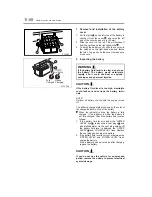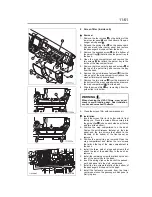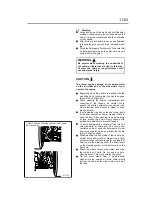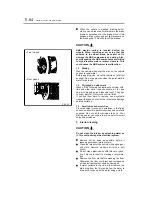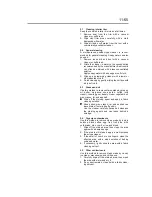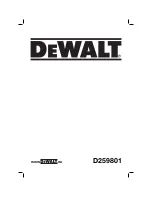
11-54
Pretrip inspection and maintenance
The amount of wear on a tire depends on its posi-
tion on the vehicle. To equalize wear and extend life
as much as possible, rotate the tires at regular inter-
vals.
•
On a single axle, use tires of the same type on
both wheels. If different types of tires are
mounted on the same axle, the vehicle tends to
pull to one side during braking, which could
cause you to lose directional control of the vehi-
cle.
•
See this table for approved tires:
NOTE:
To break in new tires, drive the first 125 miles (200
km) at 37 mph (60 km/h) or less. After this period,
check the tire pressure.
If using different tread patterns on the front and rear
wheels, select tires with a ribbed tread for the front
wheels and tires with a traction-type tread for the
rear wheels.
Tire rotation
Tire rotation intervals
Every 6000 miles
(10 000 km)
Model
Tire size
COE 40, 45
LT215/85R16-10PR
(Load Range E)
COE 50
215/75R17.5 124/123L
(Load Range F)
WARNING
•
Be sure to use tires of the approved type.
Mixing bias and radial tires results in
impaired steering and could cause an
injury accident or loss of life.
•
After a wheel has been replaced, the wheel
nuts will loosen somewhat as they wear in,
creating a potential for an injury accident.
Tighten the wheel nuts again after you
have driven 30 to 60 miles (50 to 100 km).
Z12089
Same tread pattern on all tires
Front
Rear
Z12090
Different tread patterns on front and rear tires
Front
Rear
Summary of Contents for 360
Page 13: ...2 1 Locations in cab 2 2 Locations outside cab 2 4 2 Warning labels ...
Page 16: ...2 4 Warning labels Locations outside cab Z12496 ...
Page 19: ...2 7 Warning labels 30 gallon 113 liter fuel tank Z12494 ...
Page 27: ...4 1 Seats 4 2 Seat belts 4 4 Steering wheel 4 7 4 Seat and steering wheel adjustments ...
Page 204: ...14 1 Maintenance schedule 14 2 Lubrication schedule 14 6 14 Maintenance schedule ...
Page 210: ...15 1 15 Alphabetical index ...



















